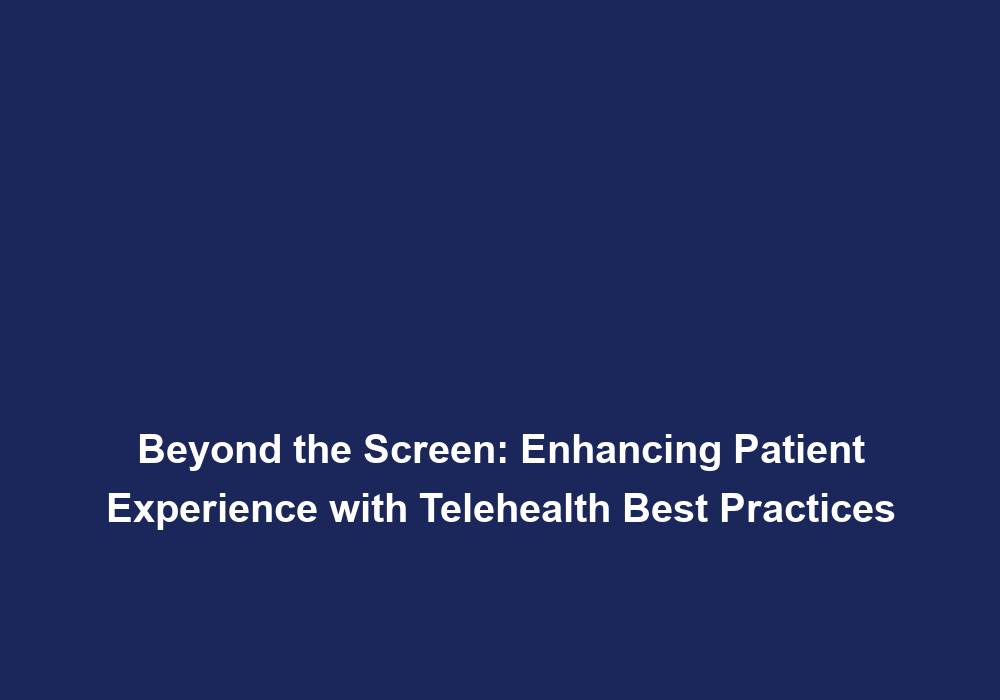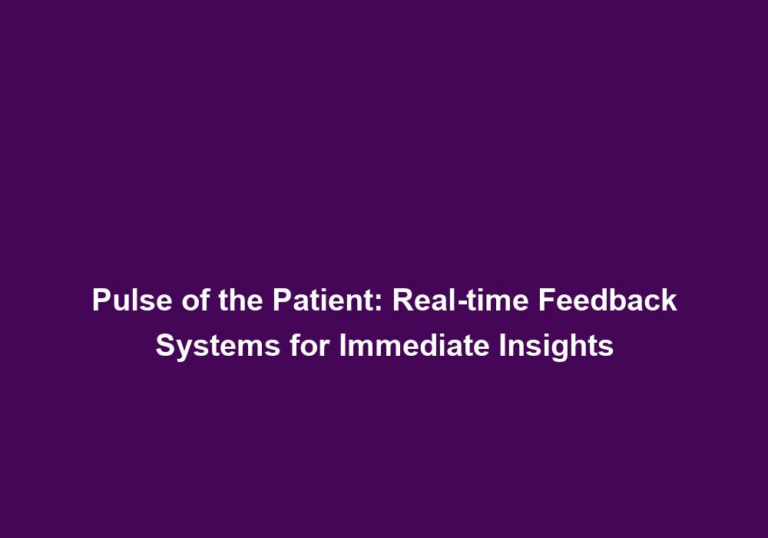Beyond the Screen: Enhancing Patient Experience with Telehealth Best Practices
Telehealth has revolutionized the healthcare industry by providing patients with convenient and accessible medical services. With advancements in technology, healthcare providers have been able to bridge the gap between patients and healthcare professionals, offering virtual consultations, diagnoses, and treatment options. In this article, we will explore the best practices for enhancing patient experience with telehealth, ensuring that patients receive high-quality care and support beyond the screen.
Understanding the Patient Perspective
To truly enhance the patient experience with telehealth, it is crucial to understand their perspective and address their concerns. Patients may feel apprehensive or skeptical about receiving medical care through virtual platforms. By acknowledging their concerns and providing reassurance, healthcare providers can build trust and confidence in telehealth services.
Empathy and Communication
Empathy plays a vital role in creating a positive patient experience. Healthcare providers should prioritize effective communication during telehealth consultations. They must actively listen to patients, express empathy, and ensure that patients’ concerns are fully understood and addressed.
- Actively listen to patients: Take the time to listen attentively to patients’ concerns, allowing them to express themselves fully and feel heard.
- Express empathy: Show understanding and compassion towards patients, acknowledging their emotions and validating their experiences.
- Address concerns: Take the time to address any concerns or doubts patients may have about telehealth, providing clear and concise explanations to alleviate their fears.
Establishing a Comfortable Environment
Creating a comfortable environment is essential for patients during telehealth visits. Encourage patients to find a quiet, private space for their consultations, minimizing distractions and ensuring confidentiality. Additionally, providers should ensure that the telehealth platform is user-friendly and easy to navigate, so patients can feel confident in accessing their virtual appointments.
- Privacy and confidentiality: Emphasize the importance of finding a quiet and private location for telehealth visits to ensure patient confidentiality.
- Minimize distractions: Advise patients to turn off notifications and minimize background noise during their consultations to maintain focus and concentration.
- User-friendly platforms: Choose telehealth platforms that are intuitive and user-friendly, providing clear instructions and support for patients to navigate the virtual environment easily.
Improving Accessibility and Convenience
One of the key advantages of telehealth is its ability to provide healthcare services to individuals who may face barriers to traditional in-person care. By adopting best practices, healthcare providers can ensure that telehealth is accessible and convenient for all patients.
Broadening Digital Access
To enhance accessibility, providers should consider the digital divide that may exist among patients. Offering telehealth services through multiple platforms, such as web browsers, mobile applications, or telephone consultations, can accommodate patients with varying levels of digital literacy and access to technology.
- Web browsers: Enable telehealth consultations through web browsers, allowing patients to access virtual appointments directly from their desktop or laptop computers.
- Mobile applications: Develop user-friendly telehealth apps that can be easily installed on smartphones or tablets, providing a convenient option for patients on the go.
- Telephone consultations: For patients with limited access to technology or digital literacy, offer telehealth consultations via telephone, ensuring that they can still receive medical care remotely.
Flexible Scheduling
Telehealth provides patients with the flexibility to schedule appointments that suit their convenience. Healthcare providers should prioritize offering extended hours or weekend availability to accommodate diverse patient needs. Implementing online appointment scheduling systems can further streamline this process, allowing patients to easily book and manage their telehealth appointments.
- Extended hours: Extend the availability of telehealth appointments beyond regular office hours, allowing patients to schedule consultations after work or on weekends.
- Online appointment scheduling: Implement user-friendly online appointment scheduling systems that enable patients to conveniently book, reschedule, or cancel telehealth appointments at their convenience.
Ensuring Privacy and Security
Maintaining patient privacy and data security is crucial in telehealth. Healthcare providers must adhere to strict privacy regulations and implement robust security measures to protect sensitive patient information.
HIPAA Compliance
Health Insurance Portability and Accountability Act (HIPAA) compliance is essential in telehealth to safeguard patient data. Telehealth platforms should be HIPAA compliant, ensuring that patient information remains confidential and is shared securely between healthcare providers and patients.
- Use HIPAA-compliant platforms: Choose telehealth platforms that meet HIPAA requirements, providing end-to-end encryption and secure data transmission.
- Educate staff on HIPAA: Train healthcare providers and staff on HIPAA regulations and the importance of maintaining patient privacy and confidentiality during telehealth consultations.
Secure Telehealth Platforms
Utilizing secure telehealth platforms with end-to-end encryption is imperative to protect patient privacy. Healthcare providers should invest in reputable telehealth software that prioritizes data security, reducing the risk of unauthorized access or data breaches.
- Encryption and data protection: Ensure that telehealth platforms utilize encryption techniques to protect patient data both during transmission and storage.
- Regular security updates: Stay updated with the latest security patches and software updates to address any vulnerabilities and ensure a secure telehealth environment.
Enhancing Patient-Provider Relationship
Building strong patient-provider relationships is important in telehealth to ensure continuity of care and patient satisfaction. Implementing best practices can foster trust and collaboration between patients and healthcare professionals.
Continuity of Care
Telehealth should be seamlessly integrated into a patient’s overall healthcare journey. By coordinating with in-person providers, healthcare professionals can ensure continuity of care, share medical records, and collaborate on treatment plans. This collaborative approach strengthens the patient-provider relationship and enhances the overall patient experience.
- Collaboration with in-person providers: Establish effective communication channels between telehealth providers and in-person healthcare teams to ensure a holistic approach to patient care.
- Share medical records: Implement secure systems for sharing medical records and test results between telehealth providers and in-person healthcare professionals.
- Treatment plan coordination: Collaborate with in-person providers to develop comprehensive treatment plans, ensuring continuity of care even when consultations are conducted virtually.
Follow-up and Support
Providing follow-up care and support is crucial to ensure patient satisfaction and optimize health outcomes. Telehealth allows for timely follow-up appointments, medication reviews, and answering patient queries. Healthcare providers should proactively engage with patients, ensuring that they are supported throughout their healthcare journey.
- Timely follow-up appointments: Schedule follow-up telehealth appointments to monitor progress, adjust treatment plans, and address any concerns or questions patients may have.
- Medication reviews: Utilize telehealth to conduct medication reviews, ensuring that patients are taking their prescribed medications correctly and experiencing no adverse effects.
- Proactive engagement: Reach out to patients between appointments via telehealth to provide ongoing support, answer questions, and offer guidance for self-care.
In conclusion, telehealth has the potential to greatly enhance the patient experience by providing convenient, accessible, and high-quality healthcare services. By prioritizing empathy, effective communication, accessibility, privacy, and continuity of care, healthcare providers can ensure that patients receive exceptional care beyond the screen. Implementing best practices in telehealth will not only improve patient satisfaction but also empower individuals to actively participate in their own healthcare.






